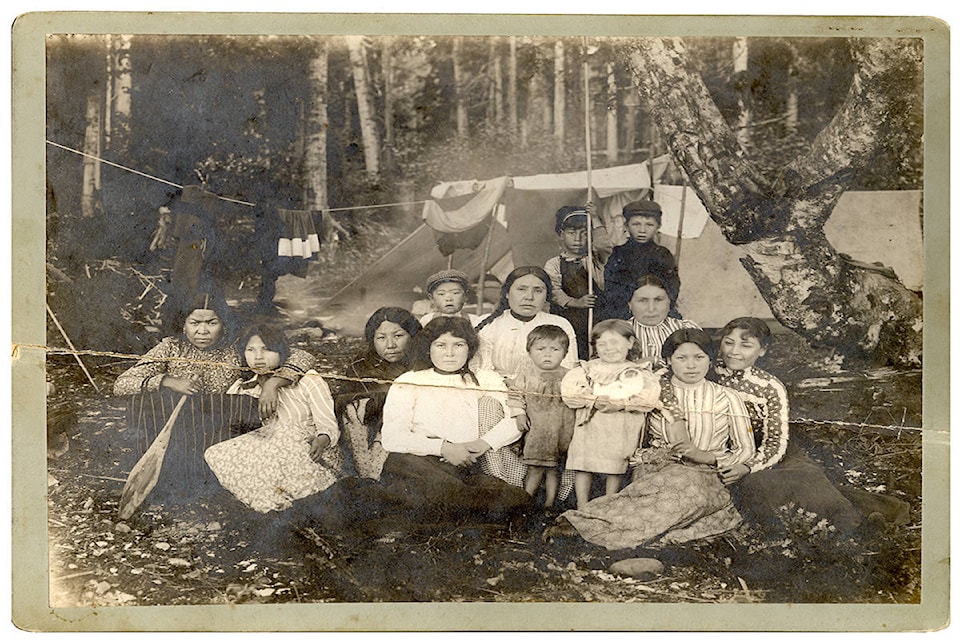Tsi-tsikalam: a Kwakwaka’wakw word meaning stories to be told.
The word couldn’t ring more true for Maureen Glowasky, a fourth-generation Courtenay resident who recently found the story that needed to be told from a black-and-white photograph she pulled out of her grandmother’s burn pile more than 60 years ago.
The photo – a yellowed, cracked and torn print featuring a group of First Nations women, girls and boys at a camp – was originally Glowasky’s grandmother’s image, and is estimated to be around 100 years old.
“In April, 1953 … everyone was over for the funeral. My aunt … wanted to clear out a lot of stuff, and one of the things was that picture. That picture was on a pile - I remember that pile in the middle of the driveway where Lake Trail School is now.”
For some reason, says Glowasky, she picked up the picture. There was something that made her pick it up and take it home.
Her sister Mary Anne explains she seems to remember their grandmother noting the photo was of friends. She thinks the photo may have been a wedding present.
Glowasky agrees.
“Over time I kept looking at the girl (in the middle) - I wanted to know her history … she seemed to be talking to me. I felt there was more to her story; I had to put it out (there) to tell her side.”
She enlisted help from Linda Graceffo of Sparkling Graphics, who helped Glowasky restore the image.
Graceffo describes the original image as “cardboard … it was literally just cracked.”
She believes the hardest part was restoring the faces and preserving details.
“When Maureen first gave it to me, I thought: ‘you want me to do what?’ It was a lot of hours; it was in very bad shape.”
Once restored, Graceffo suggested to Glowasky to place the image in the Comox Valley Record. In the March 17, 2006 edition, the photo ran with the caption: ‘This photo is believed to have been taken about 100 years ago. Do you know anything about it?’
Years later in 2015, Glowasky was at Courtenay Market Days with her friend when she came across the image in the Courtenay One Hundred Years of History 1915 - 2015 souvenir booklet.
“I was so excited about finding that book - and as soon as I could I got to the museum and bumped into (historian Catherine Siba) who put me on to the rest.”
The photo has extra meaning for Wedlidi Speck, who identified the woman in the centre of the image as Tesekla, who came to the Comox Valley from Cape Mudge, most likely for fish and potatoes.
Glowasky notes her family was involved with potato farming, and the camp was most likely on the family farm.
Speck says seeing the image was “really exciting” because he had been looking for larger family pictures, as the name has significance in his family.
“When I married, I named my eldest after her. So she was named Tesekla. But unfortunately, my daughter passed away when she was 25 from epilepsy. In our culture, names lie in rest for awhile. After a period of time, we have a ceremony, and put a white blanket over a child who is going to be named after her. And that’s happened. So we had a feast and we put a blanket on the child and we said we’re taking the name now and we’re putting it on the new Tesekla.”
The name has been passed along from Speck’s aunt, his daughter and now his niece, and he adds he can now track four generations.
The name is an important K’ómoks name.
“It’s believed to have two ancestors of the K’ómoks clans who came down from Quinsam, and one of them was Tesekla. So all the people who are named after that, are related to that ancestor, so it’s really fascinating.”
Siba notes every now and again she will meet people at the museum doing research who are able to connect the dots through history and have an ‘ah-ha’ moment.
“It’s wonderful to see, and getting (Glowasky and Speck) together - it’s wonderful.”
Maureen and Mary Anne both agree it was extremely important for them to find the story behind the photo and share it as much as they could.
“That’s history we have not heard - never seen. And I think it’s history that should be brought out,” adds Mary Anne.
“I have very few words in my vocabulary,” says Speck with a smile.
“And awesome is one of them. This is awesome.”



